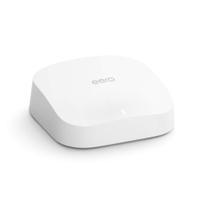What is wired backhaul, and should your mesh network be using it?

Over the years, mesh Wi-Fi has become a very popular choice. The ability to blanket your entire home with Wi-Fi coverage with just a few access points in range of one another is incredible, and it's especially useful if you have a larger residence. However, mesh networks do suffer from one notable flaw: signal degradation. Thankfully, this issue can be solved by the usage of wired backhaul. Here’s a look at what wired backhaul is, as well as why you’ll want to have it.
What is wired backhaul?
Wired backhaul refers to a physical wired ethernet connection between a mesh network’s primary access point (the one that’s hooked up to your modem and acts as your router) and its secondary access points. This adds another channel of communication between the primary and secondary access points.
Why you should use wired backhaul
The reason most people should consider using wired backhaul is because of signal degradation, which occurs naturally without the presence of ethernet cables.
When you connect a device to a secondary access point in a mesh network, everything you do on it is broadcast wirelessly from your primary access point to the secondary one, and then its rebroadcast to your device from the secondary access point. As this is happening, the original signal from the primary access point is being degraded for two reasons. The first is because of the distance between your primary and secondary access points. The farther distance your primary access point has to broadcast to a secondary one, the worse the signal will be.
The second cause of signal degradation is the secondary access point’s rebroadcast to your device. Since the access point is rebroadcasting a signal that it received from the primary router, the signal it rebroadcasts typically won’t be as strong as the signal it originally received.
Both problems can be eliminated through the use of wired backhaul. This is because the ethernet connection between the access points removes the need for the primary access point to broadcast a signal to secondary ones, rendering the issues of both distance and rebroadcast signal quality non-existent. With wired backhaul, you effectively make every access point as strong and stable as the primary router since all of them are connected through cables.
The mesh network we recommend

If you’re looking for a mesh network that performs excellently and is compatible with wired backhaul, look no further than eero’s latest offerings. Both the eero 6 and the eero Pro 6 are mesh-compatible, meaning that you can use several of them to setup your own mesh network. Additionally, both of them support Wi-Fi 6, which is quickly becoming the new Wi-Fi standard due to its higher speed and stability. Wi-Fi 6 is the future, so investing in a Wi-Fi 6 wireless network now is a good idea.
The eero 6 is dual-band and has a range of up to 1,500 square feet, and it costs $129. Meanwhile, the eero Pro 6 steps things up with tri-band and a 2,000 square foot range, but also costs more at $229. In general, the eero 6 is ideal for setting up mesh networks in medium homes or if you want to save money, while the eero Pro 6 is perfect for folks who want to bring mesh networking to large residences or enjoy the improved stability that tri-band brings to the table.
The eero 6 features excellent coverage and a dual-band configuration for strong stability, though it's not as top-notch as the pro version. Because of that, though, it's more affordable.
The eero Pro 6 offers superb coverage and a tri-band configuration for amazing stability, though it's a little more expensive.
Get daily insight, inspiration and deals in your inbox
Sign up for breaking news, reviews, opinion, top tech deals, and more.

